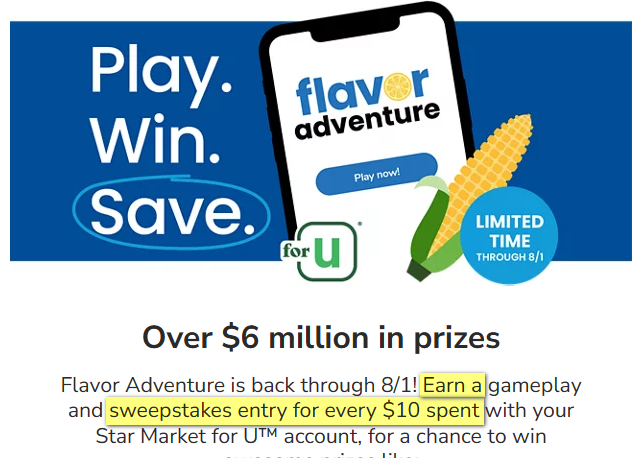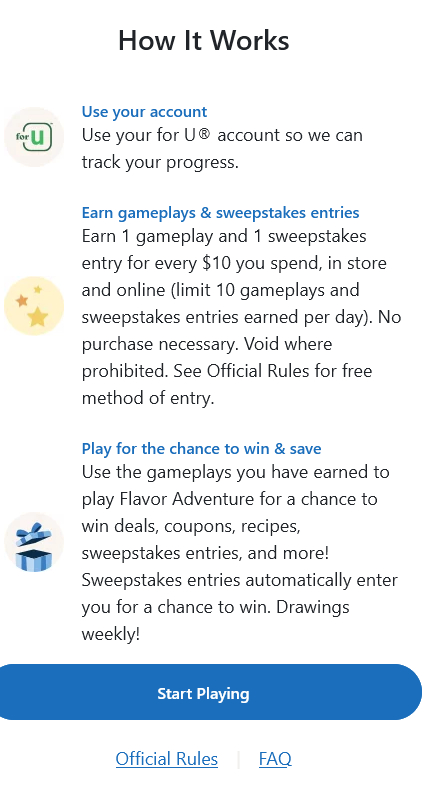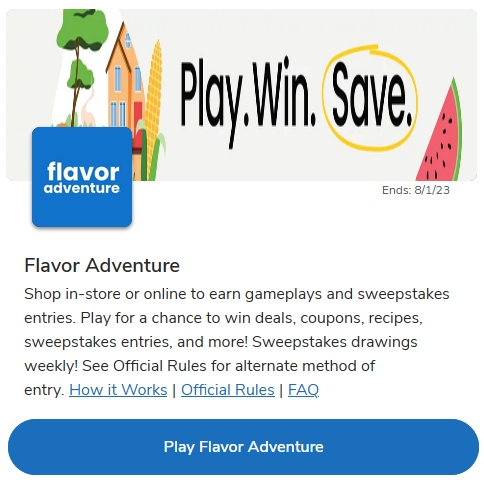In early June, a number of the Albertsons Companies supermarket chains (Acme, Albertsons, Carrs, Jewel-Osco, Pavilions, Randalls, Safeway, Shaw’s, Star Market, Tom Thumb, and Vons) began running a “Flavor Adventure” sweepstakes game with over $6-million in prizes. The more you spend in the store, the more entries you get.

But, no commercial enterprise can require you to spend money in order for a chance at a prize — that is the classic definition of an illegal lottery. They have to offer a simple, free method whereby anyone can enter without making a purchase. That is called an “alternate method of entry” (AMOE). So at the bottom of the company’s email shown above in (too) tiny type is information about that free means of entry with the magic words “no purchase necessary.”
*MOUSE PRINT:

That footnote says to find out the free AMOE you have to visit this link (called “rules”) or for all the details, this link called “Official Rules.” They both take you to the same place. [Note: URLs depersonalized]
Buried in those rules is the free method of entry:
*MOUSE PRINT:

Rather than tell you in simple terms where to send in an entry, like your name and address on a 3 x 5 card, or provide a specific URL, it just says to go to the promotion website, click on the menu, and then the rules button, etc. Didn’t I already click on the rules and now it telling me to do it again. And which menu on the website am I supposed to click?
But let’s play along. Going to the promotion’s website, [page varies for non-loyalty club members] brings us here. There is no menu, but there is a “play now” button and farther down the page yet another link to the official rules.

If you click “play now” the next page gives you a pop-up that among other things says you have to be a loyalty club member to participate (itself a questionable requirement), and yet another instruction to “See Official Rules for free method of entry.” OMG. Do you feel like you are being sent in circles?

And when you click “start playing,” then you get yet another screen with instructions to see the rules about playing for free:

And if you click that button, you get yet another button to start the game.

Clicking that button brings up what appears to be the actual start of the game… but nowhere to be seen is how you enter the sweepstakes without having to demonstrate that you bought groceries at the store.

I invite intrepid readers to spend time reading the rules, and trying various options on the website to find where exactly the free method of entering the sweepstakes has been hidden and to report in the comments what steps you had to go through to get there. There is an answer and believe it or not, you have not seen the most obnoxious part yet!
In our view, the free means of entry that Albertsons Companies has created is illusory because of the complicated series of hoops they created for nonpurchasers to follow that most people will likely abandon. In essence, the alternative means of entry has failed of its essential purpose. And if that is the case, a consumer-sympathetic judge might deem the Albertsons promotion to be an illegal lottery.
Why would any company make it so difficult for their customers (and noncustomers) to participate in this game? Then it dawned on me. What if it was in their financial interest to make it harder? A scan of the official rules provided a possible answer.
*MOUSE PRINT:
![]()
Of the over $6.6-million in prizes being offered, only $1.25-million-worth are prizes over $25 for shoppers. That means as much as $5-million of the smaller prizes if they go unclaimed never have to be given away. Obviously, we don’t know the company’s motivation in designing the sweepstakes as they did.
We posed some very pointed questions in multiple inquiries to the Albertsons Companies’ PR folks, including whether they consumer-tested the no-purchase-necessary-method of entry to see if average humans could follow their instructions. They did not respond.
This promotion cries out for action by the FTC and the consumer bar.


